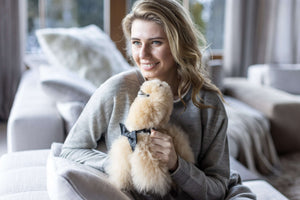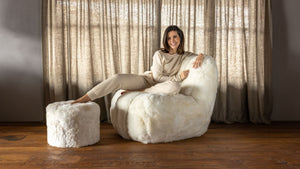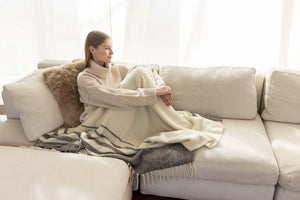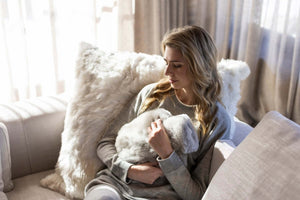FAQs
ANIMAL WELFARE AND HUSBANDRY
Are alpacas killed exclusively for fur production?
For our fur products, we use fur from animals that have not been bred exclusively for fur production. In this sense, the fur is an exclusive by-product of wool production, the use of which consistently carries on the idea of full utilisation. Since the alpaca farmer receives a lower sales price for a single pelt than for the wool of a shearing due to the downstream, complex processing of the raw material, he also has no economic motives to harm the animals.
Can you prove that the animals are not being harmed? How do you verify this?
From the very beginning, we have made the treatment and welfare of animals, but also the assumption of social responsibility, our priority as part of our corporate concept in order to achieve an ethically unobjectionable product experience. That is why our partners in Peru are handpicked and personally selected by us. Our founders have in some cases lived in Peru for an extended period of time to find the manufactures and partners that fit this concept. Even today, we regularly make sure through personal visits on site that these standards are met. This includes decent and good working conditions and excludes child labour.
Under what conditions are the alpacas kept?
The alpacas live in small herds of 80 to 100 animals in the highlands of the Peruvian Andes, in their natural habitat. There they graze freely during the day in the vastness of the mountain ranges and are sheared once a year to obtain their wool and preserve their way of life. For the Peruvian alpaca farmers, the alpacas are of inestimable importance due to the value of their wool. With a life expectancy of up to 20 years, the sale of this wool sustains the farmers and their families for the lifetime of the animals. Their welfare, protection and health are therefore a top priority for the farmers.
RAW MATERIAL ALPACA
What is the quality of our skins?
Our manufacturers specialise exclusively in alpaca fur and wool. We only use the most valuable fibre quality for our fur products: "Royal Alpaca". This means that the fibre thickness of our skins is less than 20 microns (micrometres), comparable to that of cashmere or silk. This quality is regularly assured by random sampling in independent laboratory tests. Most of our products are tested between 15 and 17 microns. But it is not only the fibre quality that is decisive for our high-quality end products, it is the special finishing process we use to give this unique fibre its incomparable softness. We also use only the finest quality grade for our wool products: "Ultrafine Alpaca" (20-23 microns).
You offer products made of SURI Alpaca and HUACAYA Alpaca. What is the difference?
There are two types of alpaca that differ only in their coat structure: the Huacaya and the Suri. The Huacaya animals have a rather short, wonderfully dense and downright fluffy coat that has a magical attraction and irresistibly invites you to touch it. The Suri animals have a loose, particularly silky coat with a unique light reflection that creates a beautiful, natural sheen and is therefore particularly suitable for effective decoration.
What is special about alpaca fur and wool?
Alpaca fibre is easy to care for and has unique thermal properties, because in their natural habitat alpacas are often exposed to extreme environmental conditions and high temperature fluctuations. The fibre is hollow on the inside and therefore thermally insulating - a unique fibre property that is very warming on cold winter days and rather cooling on warm days. Alpaca naturally contains hardly any lanolin (wool grease). This makes products made from this fibre particularly suitable for allergy sufferers, babies and the most sensitive skin. Furthermore, alpaca is dust-repellent, self-cleaning and low in lint as well as almost completely free of pilling (wool products).
Why is alpaca more sustainable than cashmere?
Alpacas are very gentle on the grazing land due to their special toe shape. Unlike cashmere goats, they graze only above the sward and thus do not damage the roots of the grass. The pasture grows back naturally and can be grazed several times. In Kashmir, due to the enormous boom of recent years, there is a dramatic shortage of grazing land due to the desertification of the original grazing areas. Alpacas are also extremely efficient animals with very low feed and water consumption. Due to its equivalent quality, alpaca is thus considered a more sustainable and unique alternative to the widely used cashmere.
SERVICE AND OFFER
Can you also offer custom-made products?
Yes, all home textiles made of alpaca fur (cushions, blankets, rugs) are handmade in our manufactory near Lima and can therefore also be produced according to individual customer wishes. We can take into account different dimensions, colours, but also individual shapes. The delivery time for our individually customised products is approximately 8-10 weeks.
Who can I contact if I notice damage to a product?
Defects that are not your fault, for example a damaged zip, will of course be repaired or replaced by us free of charge. A short e-mail to support@weich-alpaca.com is sufficient and our customer service will contact you immediately.
CLEANING AND CARE
How sensitive is the fur and how can I clean it?
Alpaca products are uncomplicated and easy to care for. Due to the special texture and the natural robustness of the fur, alpaca products made of fur rarely need to be cleaned. There is no need to worry about damage. In order to maintain the unique properties of the fibre, we recommend occasionally shaking out the larger products in the fresh air and, if necessary, gently vacuuming the alpaca fur. For smaller products, regular brushing with a wire fur brush is sufficient to maintain the natural shine. This applies especially to products made of Suri fur. For coarse soiling, professional cleaning is recommended.
Our products made of fine alpaca wool can be washed in the wool wash cycle with a wool detergent at a lukewarm temperature (30°).
Faqs
ANIMAL WELFARE AND HUSBANDRY
Are alpacas killed solely for their fur?
For our fur products, we use fur from animals that have not been bred exclusively for fur production. In this sense, the fur is an exclusive by-product of wool production, the use of which consistently continues the idea of full utilization. As the alpaca farmer achieves a lower selling price for an individual hide than for the wool of a shearing due to the downstream, time-consuming processing of the raw material, he has no economic motives to harm the animals.
Can you prove that the animals are not being harmed? How do you check this?
From the very beginning, we have made the treatment and welfare of animals as well as the assumption of social responsibility part of our corporate concept in order to achieve an ethically sound product experience. That is why our partners in Peru are hand-picked and personally selected by us. Some of our founders have lived in Peru for an extended period of time in order to find the manufacturers and partners that fit into this concept. We still make regular personal visits to ensure that these standards are being met. This includes humane and good working conditions and excludes child labor.
Under what conditions are the alpacas kept?
Alpacas live in small herds of 80 to 100 animals in the highlands of the Peruvian Andes, in their natural habitat. There they graze freely during the day in the vastness of the mountain ranges and are shorn once a year to obtain their wool and preserve their way of life. For the Peruvian alpaca farmers, the alpacas are of inestimable importance due to the value of their wool. With a life expectancy of up to 20 years, the sale of this wool feeds the farmers and their families for the entire lifetime of the animals. Their welfare, protection and health are therefore a top priority for the farmers
RAW MATERIAL ALPACA
What is the quality of our skins?
Our factories specialize exclusively in alpaca fur and wool. We only use the most valuable fiber quality for our fur products: "Royal Alpaca". This means that the fiber thickness of our skins is less than 20 microns (micrometers), which is comparable to that of cashmere or silk. This quality is regularly ensured by random samples in independent laboratory tests. Our products are usually tested at between 15 and 17 microns. But it is not only the fiber quality that is decisive for our high-quality end products, it is the special finishing process that we use to give this unique fiber its incomparable softness. We also only use the finest quality grade for our wool products: "Ultrafine Alpaca" (20-23 micrometers).
You offer products made from SURI Alpaca and HUACAYA Alpaca. What is the difference?
There are two types of alpaca, which differ only in their coat structure: the Huacaya and the Suri. The Huacaya animals have a rather short, wonderfully dense and extremely fluffy coat, which has a magical attraction and irresistibly invites you to touch it. The Suri animals have a loose, particularly silky coat with a unique light reflection that creates a beautiful, natural sheen and is therefore particularly suitable for effective decoration.
What is so special about alpaca fur and wool?
Alpaca fiber is easy to care for and has unique thermal properties, as alpacas are often exposed to extreme environmental conditions and high temperature fluctuations in their natural habitat. The fiber is hollow on the inside and therefore thermally insulating - a unique fiber property that has a very warming effect on cold winter days and a cooling effect on warm days. Alpaca naturally contains hardly any lanolin (wool grease). This makes products made from this fiber particularly suitable for allergy sufferers, babies and the most sensitive skin. In addition, alpaca is dust-repellent, self-cleaning, low-linting and almost completely free of pilling (wool products).
Why is alpaca more sustainable than cashmere?
Alpacas are very gentle on the pasture due to their special toe shape. Unlike cashmere goats, they only graze above the sward and therefore do not damage the roots of the grass. The pasture grows back naturally and can be grazed several times. In Kashmir, the enormous boom of recent years has led to a dramatic shortage of pastureland due to the desertification of the original grazing areas. Alpacas are also extremely efficient animals with very low feed and water consumption. Due to its equivalent quality, alpaca is therefore considered a more sustainable and unique alternative to the widely used cashmere.
SERVICE AND OFFER
Can you also offer customized products?
Yes, all home textiles made from alpaca fur (cushions, blankets, rugs) are handmade in our factory near Lima and can therefore also be produced according to individual customer requirements. We can accommodate different sizes, colors and individual shapes. The delivery time for our individually customized products is around 8-10 weeks.
Who can I contact if I notice damage to a product?
Defects that are not your fault, such as a damaged zipper, will of course be repaired or replaced by us free of charge. Just send a short email to support@weich-alpaca.com and our customer service team will get back to you immediately.
CLEANING AND CARE
How sensitive is the coat and how can I clean it?
Alpaca products are uncomplicated and easy to care for. Due to the special nature and natural robustness of the fur, alpaca products made of fur rarely need to be cleaned. There is no risk of damage. In order to maintain the unique properties of the fiber, we recommend shaking out larger products occasionally in the fresh air and, if necessary, gently vacuuming the alpaca fur. For smaller products, regular brushing with a wire fur brush is sufficient to maintain the natural shine. This applies in particular to products made from Suri fur. Professional cleaning is recommended for coarse soiling.
Our products made from fine alpaca wool can be washed on the wool cycle with a wool detergent at a lukewarm temperature (30°).




